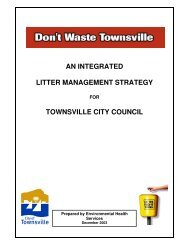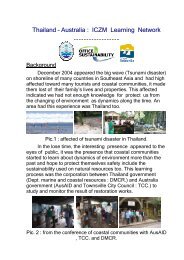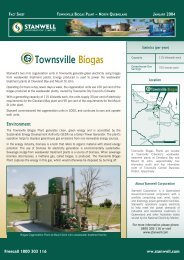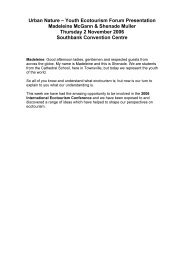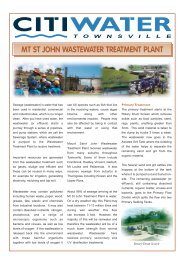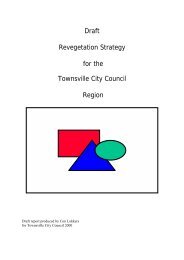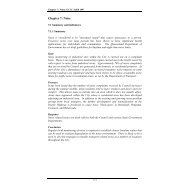ENVI RONMENTAL HI STORY OF ROWES BAY - Townsville State ...
ENVI RONMENTAL HI STORY OF ROWES BAY - Townsville State ...
ENVI RONMENTAL HI STORY OF ROWES BAY - Townsville State ...
- No tags were found...
Create successful ePaper yourself
Turn your PDF publications into a flip-book with our unique Google optimized e-Paper software.
5.4 ReclamationsEnvironmental history of Rowes BayThere has been some 18 hectares of reclamation of tidal flats, estuary, stream channels and swampsto accommodate the urban growth in these suburbs. The tidal flats between Kissing Point and CastleHill were reclaimed in two stages between 1938 – 1941, and 1960 – 1962. About 8 ha of land werereclaimed, and the stream converted to a 400 m long drain. In Belgian Gardens, Primrose Streetoccupies the former channel of Mundy Creek. This 3.5 ha area was reclaimed in the late 1960s, withthe last 0.7 ha of the Mundy Creek estuary being reclaimed by 1980. In Rowes Bay ~3 ha of swampwas reclaimed in the late 1950s when the suburb was first established, and a further 2.5 ha wasreclaimed in the early 1990s when the RSL Villas were built.5.5 Foreshore Changes5.5.1 IntroductionTerm foreshore is used loosely here to mean the modern beach ridge, which extends up to 100 mback from shoreline. The original nature of the foreshore is described above in Section 3. Most ofthe area has now been extensively modified, particularly after Cyclone Althea in late 1971. It willbe described in three sections: the Esplanade foreshore of innermost Rowes Bay, inner Rowes Bayto the One Mile Creek drain; and north Rowes Bay.5.5.2 The Esplanade foreshoreThe Esplanade foreshore extends for 500m southwest from Kissing Point headland. This is the verysheltered innermost part of Rowes Bay. The 1938 aerial photographs show this as a highly mobilesand spit shoreline. However, in the early 1950s this was stabilised, and the Esplanade roadconstructed along the foreshore in two sections either side of the North Ward drain. Houses havebeen built to within 30 m of the high tide line, and no remnant of the original foreshore remains.Urban development has thus consumed all of the foreshore area here. Since the early 1980s themudflats have become progressively colonised by mangroves.5.5.3 Inner Rowes Bay foreshoreThe inner Rowes Bay foreshore comprises a 600 m long by up to 60 m wide strip from SoroptimistsPark to the One Mile Creek drain, that is now intensively managed public parkland. There is nodirect information on the use of the foreshore until the late 1930s. By that time, although thevegetation had been changed, the foreshore still retained its original landforms of low dunes,swales, and sand spits.The southern part of the area once contained the estuary of Mundy Creek, and its associated highlymobile sand spits. The creek was cut off in 1962 after the completion of the One Mile Creek drain,and the area was eventually filled and landscaped in 1978. One small remnant of the estuarysurvives today - a small depression 200 m long and 50 m wide which contains a total of about 75mangrove trees, with approximately equal numbers of Avicennia, Ceriops, Rhizophora species.After the landscaping, the area remained undeveloped until the early 1990s when the SorpotimistsPark was constructed.The northern part of this foreshore area has had a longer history of modification. A swimmingenclosure had been built on the beach here by the late 1930s, and there were many holiday huts onthe landward side of Heatley's Parade (see Section 5.3). However, the foreshore itself remained in alargely natural state until the mid-1950s when a replacement swimming enclosure and associatedtoilet blocks were constructed. The Rowes Bay Caravan Park was also built at this time, andrecreational use of the foreshore greatly increased, although formal park facilities were notprovided. In the late 1970s the area began to be more intensively landscaped and managed as apublic park, and in the late 1980s the swimming enclosure was removed. By the mid-1990s almostthe whole foreshore between One Mile Creek and Sorpotimists Park had been landscaped and theoriginal landforms lost.9



